 W
WA brain is an organ that serves as the center of the nervous system in all vertebrate and most invertebrate animals. It is located in the head, usually close to the sensory organs for senses such as vision. It is the most complex organ in a vertebrate's body. In a human, the cerebral cortex contains approximately 14–16 billion neurons, and the estimated number of neurons in the cerebellum is 55–70 billion. Each neuron is connected by synapses to several thousand other neurons. These neurons typically communicate with one another by means of long fibers called axons, which carry trains of signal pulses called action potentials to distant parts of the brain or body targeting specific recipient cells.
 W
WThe artery of Percheron (AOP) is a rare anatomical variation in the brain vascularization in which a single arterial trunk arises from the posterior cerebral artery (PCA) to supply both sides of the thalamus and midbrain.
 W
WThe blood–brain barrier (BBB) is a highly selective semipermeable border of endothelial cells that prevents solutes in the circulating blood from non-selectively crossing into the extracellular fluid of the central nervous system where neurons reside. The blood-brain barrier is formed by endothelial cells of the capillary wall, astrocyte end-feet ensheathing the capillary, and pericytes embedded in the capillary basement membrane. This system allows the passage of some molecules by passive diffusion, as well as the selective transport of various nutrients, ions, organic anions, and macromolecules such as glucose, water and amino acids that are crucial to neural function.
 W
WIn human neuroanatomy, brain asymmetry can refer to at least two quite distinct findings:Neuroanatomical differences between the left and right sides of the brain Lateralized functional differences: lateralization of brain function
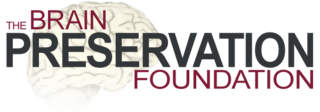 W
WThe Brain Preservation Foundation is an American non-profit organization with the goal of promoting validated scientific research and technical services development in the field of whole brain preservation for long-term static storage, as well as working on the accessibility, affordability, and sustainability of this technology. It also provides public education on topics such as the neural foundations of memory, brain scanning techniques, brain preservation, and mind uploading.
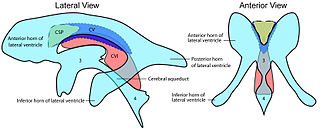 W
WIn the brain, the cavum veli interpositi (CVI) is a condition in which the cistern of the velum interpositum becomes dilated. The phenomenon usually occurs in newborns.
 W
WThe cavum Vergae is a posterior extension of the cavum septi pellucidi, an anomaly that is found in a small percentage of human brains. It was first described by Andrea Verga.
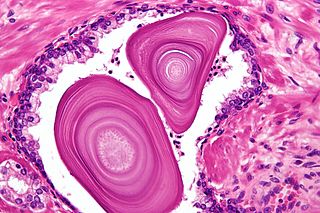 W
WCorpora amylacea (CA) is a general term for small hyaline masses found in the prostate gland, nervous system, lung, and sometimes in other organs of the body. Corpora amylacea increase in number and size with advancing age, although this increase varies from person to person. In the nervous system, they are particularly abundant in certain neurodegenerative diseases. While their significance is largely unknown, some researchers have suggested that corpora amylacea play a role in the clearance of debris.
 W
WThe frontoparietal network (FPN), generally also known as the central executive network (CEN), is a large-scale brain network primarily composed of the dorsolateral prefrontal cortex and posterior parietal cortex, around the intraparietal sulcus. It is involved in sustained attention, complex problem-solving and working memory.
 W
WA grid cell is a type of neuron within the entorhinal cortex that fires at regular intervals as an animal navigates an open area, allowing it to understand its position in space by storing and integrating information about location, distance, and direction. Grid cells have been found in many animals, including rats, mice, bats, monkeys, and humans.
 W
WThe gut–brain axis is the biochemical signaling that takes place between the gastrointestinal tract and the central nervous system (CNS). The term "gut–brain axis" is occasionally used to refer to the role of the gut flora in the interplay as well, whereas the term "microbiota–gut–brain axis" explicitly includes the role of gut flora in the biochemical signaling events that take place between the GI tract and CNS.
 W
WHow to Create a Mind: The Secret of Human Thought Revealed is a non-fiction book about brains, both human and artificial, by the inventor and futurist Ray Kurzweil. First published in hardcover on November 13, 2012 by Viking Press it became a New York Times Best Seller. It has received attention from The Washington Post, The New York Times and The New Yorker.
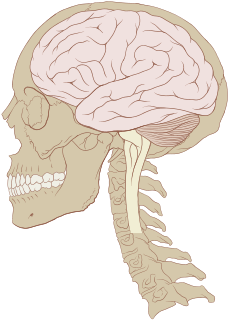 W
WThe human brain is the central organ of the human nervous system, and with the spinal cord makes up the central nervous system. The brain consists of the cerebrum, the brainstem and the cerebellum. It controls most of the activities of the body, processing, integrating, and coordinating the information it receives from the sense organs, and making decisions as to the instructions sent to the rest of the body. The brain is contained in, and protected by, the skull bones of the head.
 W
WNeurotrauma, brain damage or brain injury (BI) is the destruction or degeneration of brain cells. Brain injuries occur due to a wide range of internal and external factors. In general, brain damage refers to significant, undiscriminating trauma-induced damage, while neurotoxicity typically refers to selective, chemically induced neuron damage.
 W
WAn isolated brain is a brain kept alive in vitro, either by perfusion or by a blood substitute, often an oxygenated solution of various salts, or by submerging the brain in oxygenated artificial cerebrospinal fluid (CSF). It is the biological counterpart of brain in a vat. A related concept, attaching the brain or head to the circulatory system of another organism, is called a head transplant. An isolated brain, however, is more typically attached to an artificial perfusion device rather than a biological body.
 W
WThe human brain anatomical regions are ordered following standard neuroanatomy hierarchies. Functional, connective, and developmental regions are listed in parentheses where appropriate.
 W
WThe lobes of the brain were originally a purely anatomical classification, but have been shown also to be related to different brain functions. The cerebrum, the largest portion of the human brain, is divided into lobes, but so is the cerebellum. If not specified, the expression "lobes of the brain" refers to the cerebrum.
 W
WThe mind is the set of faculties including cognitive aspects such as consciousness, imagination, perception, thinking, intelligence, judgement, language and memory, as well as noncognitive aspects such as emotion and instinct. Under the scientific physicalist interpretation, the mind is produced at least in part by the brain. The primary competitors to the physicalist interpretations of the mind are idealism, substance dualism, and types of property dualism, and by some lights eliminative materialism and anomalous monism. There is a lengthy tradition in philosophy, religion, psychology, and cognitive science about what constitutes a mind and what are its distinguishing properties.
 W
WThe mouse brain refers to the brain of Mus musculus. Various brain atlases exist.
 W
WParental experience, as well as changing hormone levels during pregnancy and postpartum, cause changes in the parental brain. Displaying maternal sensitivity towards infant cues, processing those cues and being motivated to engage socially with her infant and attend to the infant's needs in any context could be described as mothering behavior and is regulated by many systems in the maternal brain. Research has shown that hormones such as oxytocin, prolactin, estradiol and progesterone are essential for the onset and the maintenance of maternal behavior in rats, and other mammals as well. Mothering behavior has also been classified within the basic drives. Less is known about the paternal brain, but changes in the father's brain occur alongside the mother once the offspring is born.
 W
WThe posterior commissure is a rounded band of white fibers crossing the middle line on the dorsal aspect of the rostral end of the cerebral aqueduct. It is important in the bilateral pupillary light reflex.
 W
WThe salience network (SN) is a large scale brain network of the human brain that is primarily composed of the anterior insula (AI) and dorsal anterior cingulate cortex (dACC). It is involved in detecting and filtering salient stimuli, as well as in recruiting relevant functional networks. Together with its interconnected brain networks, the SN contributes to a variety of complex functions, including communication, social behavior, and self-awareness through the integration of sensory, emotional, and cognitive information.
 W
WSeptum Verum is a region in the lower medial part of the telencephalon that separates the two cerebral hemispheres. The human septum consists of two parts: the septum pellucidum, a thin membrane consisting of white matter and glial cells that separate the lateral ventricles, and the lower, precommisural septum verum, which consists of nuclei and grey matter. The term is sometimes used synonymously with Area Septalis, to refer to the precommisural part of the lower base of the telencephalon. The Septum verum contains the septal nuclei, which are usually considered part of the limbic system.
 W
WTalairach coordinates, also known as Talairach space, is a 3-dimensional coordinate system of the human brain, which is used to map the location of brain structures independent from individual differences in the size and overall shape of the brain. It is still common to use Talairach coordinates in functional brain imaging studies and to target transcranial stimulation of brain regions. However, alternative methods such as the MNI Coordinate System have largely replaced Talairach for stereotaxy and other procedures.
 W
WThe 10 percent of the brain myth is a widely perpetuated myth that most or all humans only use 10 percent of their brains. It has been misattributed to many celebrated people, notably Albert Einstein. By extrapolation, it is suggested that a person may harness this unused potential and increase intelligence.
 W
WThe tentorial notch refers to the anterior opening between the free edge of the cerebellar tentorium and the clivus for the passage of the brainstem.
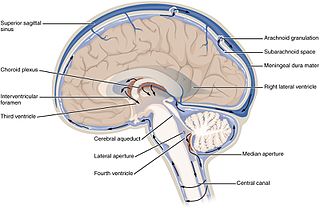 W
WThe ventricular system is a set of four interconnected cavities known as ventricles in the brain. Within each ventricle is a region of choroid plexus which produces the circulating cerebrospinal fluid (CSF). The ventricular system is continuous with the central canal of the spinal cord from the fourth ventricle, allowing for the flow of CSF to circulate.